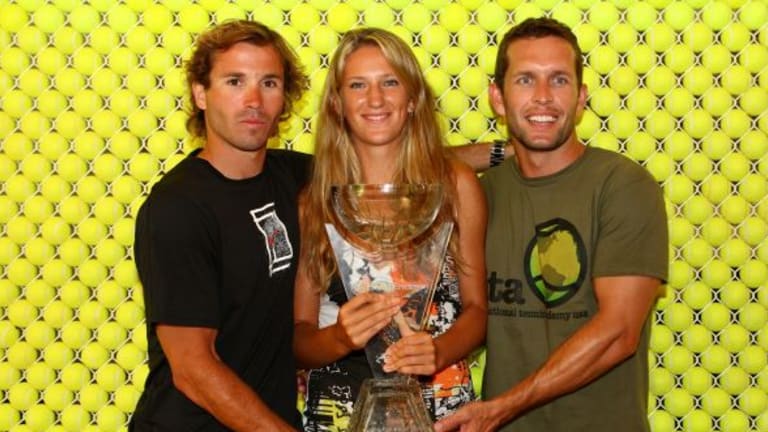**
- *
**
by Pete Bodo
Okay, so here's my theory: There's a secret lab hidden somewhere deep amid the pine trees in a rugged valley in the Urals, and it turns out female Russian tennis players. And not too long ago the technicians there got the confidential bulletin from the the WTA Tour.
Sharapova module (no. 3243STD) no longer functioning properly. Stop. Suspect engineering and material failure. Stop. Need replacement ASAP, with following modifications:
*
1 - Eliminate habit of pulling up and off forehand.
2 - Build in increased mobility and add flexibility to core.
3 - Modify serve (new circuit must ,module advance* *into court after striking ball)
4 - Improve backhand to improve open-stance, inside-out function.
5 - Decrease height by four inches, but retain narrow profile of frame.
Note: Retain shriek and tendency toward affluenza.
Priority: Top. Status: Secret. Formal model name: The Azarenka.*
Well, they rolled out the (Victoria) Azarenka here at the Sony-Ericsson Open today, and it functioned beautifully, making everyone forget the obsolete Sharapova module. Victoria Azarenka destroyed Serena Williams 6-3, 6-1 in the women's final, and while Serena wore a tan wrap on her left quadricep (but, oddly enough, talked about her ankle in the "aches and pains" portion of her presser), the tennis Azarenka played was more than persuasive - it was convincing. The statuesque, 5-10 native of Minsk, Belarus, who now resides in Scottsdale, Az., is poised to become a force in the womens game.
Azarenka, 19, was a four-time singles runner-up (but never a titlist) until this year; today she claimed her third and by far biggest title of the year, winning over an undiluted field and rolling through the woman who was on the brink of surpassing Steffi Graf's record five Miami titles. Serena will get more chances to move ahead of Graf, but the mission suddenly looks more daunting.
The contrast when the women walked onto court on this stifling, sun-baked day was striking. Azarenka looked very inch the ingenue in her mostly white outfit with exposed shoulders and a matching yellow visor (the better to show off that golden French braid spilling out and over her back). Serena's candy-corn orange dress was festive enough, but her shuffling steps and heavily strapped thigh lent her the air of a wounded veteran. But the plain white duckbill cap pulled low over her eyes suggested she was all about the substance, not the form.
Alas, the substance was missing today. She would have had to appear in a gold-sequined bikini with giant turquoise ostrich plumes cascading from her tiara to steal the show today, because nothing she brought to the court was going to do that job. Serena served 48 per cent (compared to 67 per cent by Azarenka) and distributed 12 break points that yielded five breaks. Azarenka saved three of the only four break points she faced. Oh, there were flickerings of the Serena we've come to know and love; does anyone do a better job of stepping up to the line, break-point down, and busting an ace?
The trouble is, Serena was called upon to do something like that about 8 too many times today. And it was clear that Serena, who at the best of times appears to consider the mere act of walking a burdensome demand (while gleefully knocking over furniture in order to get to the ball, once it's in play - go figure), wasn't going to keep up the pace. Still, the key to beating Serena is to make her run, then run some more (even then it's by no means a sure thing). The other key to beating Serena is to run. It takes a player with suicidal tendencies (and I don't just mean Svetlana Kuznetsova) to go square up with Serena, feet planted and chin thrust forward. Somewhere along the line, Azarenka picked up both keys and absorbed the wisdom of that old saw, You can't hit what you can't catch. I'll leave the rest to the medical experts here, of which we have an abundance (dominant specialty: lumbar region).
There isn't anything wrong with Azarenka's attitude, either. Asked if she was intimidated by the presence of Serena across the net during the warm-up, Azarenka admitted to feeling a twinge of trepidation when, upon hearing Serena's name, the packed stadium "pretty much exploded." But, she philosophically added, "I was just so happy to play against her. I like the way she plays and I just want(ed) to get a rematch (they met in the Australian Open a few months ago, but Azarenka had to quit while in command because of stomach troubles) and try to do my best."

